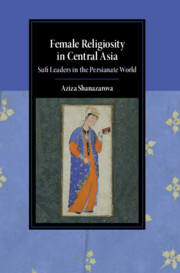Book contents
- Female Religiosity in Central Asia
- Cambridge Studies in Islamic Civilization
- Female Religiosity in Central Asia
- Copyright page
- Dedication
- Contents
- Figures
- Acknowledgments
- Abbreviations
- Introduction
- 1 Religion and Politics in Post-Timurid Central Asia
- 2 The Centrality of ʿAlidism in the Maẓhar al-ʿajāʾib
- 3 Locating the Great Lady within the Sufi Milieu of Sixteenth-Century Central Asia
- 4 The Chaghatay Book of Guidance
- 5 The Portrayal of the Great Lady in the Maẓhar al-ʿajāʾib
- 6 The Great Lady and Her Hagiographers
- 7 The Great Lady in Shrine Traditions
- Conclusion
- Bibliography
- Index
- Other titles in the series:
3 - Locating the Great Lady within the Sufi Milieu of Sixteenth-Century Central Asia
Published online by Cambridge University Press: 25 April 2024
- Female Religiosity in Central Asia
- Cambridge Studies in Islamic Civilization
- Female Religiosity in Central Asia
- Copyright page
- Dedication
- Contents
- Figures
- Acknowledgments
- Abbreviations
- Introduction
- 1 Religion and Politics in Post-Timurid Central Asia
- 2 The Centrality of ʿAlidism in the Maẓhar al-ʿajāʾib
- 3 Locating the Great Lady within the Sufi Milieu of Sixteenth-Century Central Asia
- 4 The Chaghatay Book of Guidance
- 5 The Portrayal of the Great Lady in the Maẓhar al-ʿajāʾib
- 6 The Great Lady and Her Hagiographers
- 7 The Great Lady in Shrine Traditions
- Conclusion
- Bibliography
- Index
- Other titles in the series:
Summary
Chapter 3 contextualizes Aghā-yi Buzurg and her community within the Sufi milieu of sixteenth-century Central Asia by highlighting a particular aspect of this community, ṭarīqa-yi nā-maslūk (the untraveled path), one of the most frequently used designations to refer to the community in the Maẓhar al-ʿajāʾib. This chapter emphasizes the complex nature of “the untraveled path” by exploring the association of Aghā-yi Buzurg and her followers with the Khwājagān–Naqshbandī Sufi tradition. Aghā-yi Buzurg’s community was unique among Sufi groups: first, because it was guided by a woman, and second, because this woman had not been trained by a living master but instead had received her spiritual training from the enigmatic saintly figure of Khiżr, believed to be endowed with immortal life.
Keywords
- Type
- Chapter
- Information
- Female Religiosity in Central AsiaSufi Leaders in the Persianate World, pp. 63 - 75Publisher: Cambridge University PressPrint publication year: 2024

